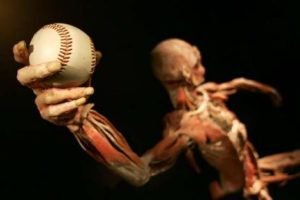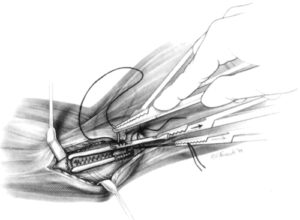 Elbow injuries from overhand throwing can be very serious and lead to long-term problems if not treated properly. These injuries can occur gradually over time as a result of the repeated stresses of throwing. They are most commonly seen in pitchers, but any athlete who participates in repetitive overhand throwing can be at risk.
Elbow injuries from overhand throwing can be very serious and lead to long-term problems if not treated properly. These injuries can occur gradually over time as a result of the repeated stresses of throwing. They are most commonly seen in pitchers, but any athlete who participates in repetitive overhand throwing can be at risk.
Some common elbow injuries seen in throwers include:
- medial epicondylitis (golfer's elbow)
- lateral epicondylitis (tennis elbow)
- ulnar collateral ligament tears or sprains (often referred to as "Tommy John surgery")
- flexor/extensor tendonitis and tendinosis
Preventing and treating these injuries involves proper technique, conditioning, warm-up and cool-down routines, as well as rest periods during practice and play. In severe cases, surgery may be necessary to repair damaged structures in the elbow.
It is important for athletes and coaches to pay attention to warning signs of overuse injury, such as pain during or after throwing, decreased throwing velocity and accuracy, and loss of range of motion in the elbow joint. Taking proper precautions can help prevent these injuries and keep athletes healthy and on the field.
Throwing Anatomy
 The elbow joint is where three bones in the arm meet: the upper arm bone (humerus) and the two bones in the forearm (radius and ulna). It is a combination hinge and pivot joint. The hinge part of the joint lets the arm bend and straighten; the pivot part lets the lower arm twist and rotate.
The elbow joint is where three bones in the arm meet: the upper arm bone (humerus) and the two bones in the forearm (radius and ulna). It is a combination hinge and pivot joint. The hinge part of the joint lets the arm bend and straighten; the pivot part lets the lower arm twist and rotate.
At the upper end of the ulna is the olecranon, the bony point of the elbow that can easily be felt beneath the skin.
On the inner and outer sides of the elbow, thick ligaments (collateral ligaments) hold the elbow joint together and prevent dislocation. The ligament on the inner part of elbow (closer to body) is called ulnar collateral ligament. It runs from inner side of humerus to inner side of ulna and must withstand extreme stress as it stabilizes elbow during overhand throwing.
Several muscles, nerves, and tendons (connective tissues between muscles and bones) cross at elbow. Flexor/pronator muscles of forearm and wrist originate at elbow and are also important stabilizers of elbow during throwing.
Ulnar nerve crosses elbow joint right behind bony prominence on inner aspect of elbow. It controls muscles hand provides sensation to small ring fingers.
Common Throwing Injuries of the Elbow
 The five most common elbow injuries in throwers are flexor tendinitis, ulnar collateral ligament injury, valgus extension overload, olecranon stress fracture, and ulnar neuritis. These injuries can cause pain during throwing, decreased throwing velocity, and pain in the elbow during rest. Treatment may include rest, physical therapy, and in severe cases, surgery. It is important for throwers to listen to their bodies and seek treatment early to prevent further damage and ensure a speedy recovery.
The five most common elbow injuries in throwers are flexor tendinitis, ulnar collateral ligament injury, valgus extension overload, olecranon stress fracture, and ulnar neuritis. These injuries can cause pain during throwing, decreased throwing velocity, and pain in the elbow during rest. Treatment may include rest, physical therapy, and in severe cases, surgery. It is important for throwers to listen to their bodies and seek treatment early to prevent further damage and ensure a speedy recovery.
Elbow injuries in throwers are usually the result of overuse and repetitive high stresses. In many cases, pain will resolve when the athlete stops throwing. It is uncommon for many of these injuries to occur in non-throwers.
In baseball pitchers, rate of injury is highly related to the number of pitches thrown, the number of innings pitched, and the number of months spent pitching each year. Taller and heavier pitchers, pitchers who throw with higher velocity, and those who participate in showcases are also at higher risk of injury. Pitchers who throw with arm pain or while fatigued have the highest rate of injury.
Most elbow injuries initially cause pain during or after throwing. They will often limit the ability to throw or decrease throwing velocity. the athletes or coaches may also notice that pitches are starting to sail high. In the case of ulnar neuritis, the athlete will frequently experience numbness and tingling of the elbow, forearm, or hand as described above.
TopVelocity Can Help You Recover From Your Throwing Injury
If you're dealing with a throwing injury, our experts at TopVelocity can help. We have the knowledge and experience to get you back on the field as quickly as possible. In addition to our physical therapy services, we also offer online programs that can be tailored to your individual needs. Contact us today for a free consultation and let us show you how we can help!



